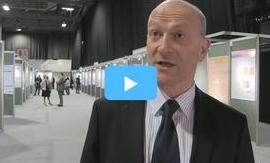Advertisment
ISH/BSH 2016: Professor Graham Jackson (Newcastle-Upon-Tyne, UK) discusses the risk factors and patient characteristics that most inform treatment selection for patients with R/R MM. Also included article 'Risk stratification in the older patient: what are our priorities?'

Risk stratification in the older patient: what are our priorities?
by Maria Dalby
Professor Sonja Zweegman, VU University Medical Centre, Amsterdam, NL
Biological age and frailty, rather than chronological age can predict survival outcomes in elderly MM patients. With dose reductions to manage the risk of toxicity, elderly patients can benefit from novel agents with similar PFS and OS to younger patients. Professor Sonja Zweegman from Amsterdam reviewed the available data and outlined a treatment algorithm based on fitness and frailty score.
Age has a negative impact on survival and elderly patients are more likely to discontinue treatment due to adverse events or death.1, 2 Patients aged over 70 are generally not candidates for autologous stem cell transplantation. Disease control is nevertheless very important in elderly MM patients as the symptoms – mainly bone disease – have a devastating impact on patients’ lives in old age. Clinical studies including the VISTA and FIRST studies show that adding an IMiD or a proteasome inhibitor to melphalan and prednisone (MP) can significantly improve OS in newly-diagnosed MM patients aged over 75 years.3-5 A sub-analysis of the MM-010 trial shows that this is also the case in RRMM: patients aged over 70 who received combination therapy with pomalidomide and low-dose dexamethasone had significantly better OS than patients receiving high-dose dexamethasone as monotherapy.6 In real life practice, patients aged over 75 years who receive MP alone or in combination with lenalidomide or bortezomib have similar PFS rates to patients aged 65-75 years; however OS is lower in patients over 75, most likely due to side effects from the first-line therapy which preclude second-line therapy.1, 7
When treating elderly MM patients it is important to be aware that fitness is not necessarily synonymous with performance status or age. A better tool for defining lack of fitness in elderly MM patients is the frailty score developed in Italy which takes into account the patient’s age together with the Katz Activity of Daily Living and Instrumental ADL tool and the Charlson Co-morbidity Index.8 The frailty score has been shown to be predictive of PFS and OS; in the case of the latter, frailty was a better predictor than either age or chromosomal abnormalities.8 A tool for calculating the myeloma frailty score is available on www.myelomafrailtyscorecalculator.net.
Studies comparing two- and three-drug regimens with bortezomib have demonstrated similar PFS and OS rates in elderly patients9, 10 but with higher rates of adverse events leading to discontinuation of treatment in frail patients.10 Similarly no difference in PFS was seen in elderly patients receiving two- and three-drug regimens with lenalidomide11 The FIRST trial shows a significant OS benefit of lenalidomide and dexamethasone compared with MP plus thalidomide in patients aged over 75.5 Once-weekly dosing of bortezomib reduces the incidence of grade 3 and 4 peripheral neuropathy and adverse events leading to discontinuation.12 According to a treatment algorithm proposed by Professor Antonio Palumbo and colleagues in Turin, elderly patients with newly diagnosed MM who are unfit (frailty score 1) should be treated with lenalidomide, 15mg daily and dexamethasone, 20mg per week, or bortezomib 1.3 mg/m2 once weekly plus MP; bortezomib and dexamethasone should be considered. In frail patients (frailty score ≥2), the initial treatment should be lenalidomide, 10 or 15mg daily or bortezomib 1.0 mg/m2 once weekly plus dexamethasone 10mg per week.8 Frail patients should be considered for inclusion in the ongoing HOVON 123 study which evaluates the feasibility and efficacy of dose-adjusted bortezomib plus MP in patients aged over 75 years. Additional studies will be required to validate the prognostic value of risk scoring and evaluating the outcomes of frailty-based treatment regimens.
References
- Bringhen S, Mateos MV, Zweegman S, et al. Age and organ damage correlate with poor survival in myeloma patients: meta-analysis of 1435 individual patient data from 4 randomized trials. Haematologica 2013;98:980-7.
- Gay F, Magarotto V, Crippa C, et al. Bortezomib induction, reduced-intensity transplantation, and lenalidomide consolidation-maintenance for myeloma: updated results. Blood 2013;122:1376-83.
- San Miguel JF, Schlag R, Khuageva NK, et al. Persistent overall survival benefit and no increased risk of second malignancies with bortezomib-melphalan-prednisone versus melphalan-prednisone in patients with previously untreated multiple myeloma. J Clin Oncol 2013;31:448-55.
- Fayers PM, Palumbo A, Hulin C, et al. Thalidomide for previously untreated elderly patients with multiple myeloma: meta-analysis of 1685 individual patient data from 6 randomized clinical trials. Blood 2011;118:1239-47.
- Hulin C. EFFECT OF AGE ON EFFICACY AND SAFETY OUTCOMES IN PATIENTS WITH NEWLY DIAGNOSED MULTIPLE MYELOMA RECEIVING LENALIDOMIDE AND LOW-DOSE DEXAMETHASONE (RD): THE FIRST TRIAL. Haematologica 2015;100:1-804.
- Petrucci MT, Levi A, Bringhen S, et al. Bortezomib, melphalan, and prednisone in elderly patients with relapsed/refractory multiple myeloma: a multicenter, open label phase 1/2 study. Cancer 2013;119:971-7.
- Hulin C, Rodon P, Campion L, et al. Clinical Characteristics, Chromosomal Abnormalities and Outcomes in Very Elderly Patients with Multiple Myeloma: The IFM Experience. Blood 2012;120:204-204.
- Palumbo A, Bringhen S, Mateos MV, et al. Geriatric assessment predicts survival and toxicities in elderly myeloma patients: an International Myeloma Working Group report. Blood 2015;125:2068-74.
- Niesvizky R, Flinn IW, Rifkin R, et al. Community-Based Phase IIIB Trial of Three UPFRONT Bortezomib-Based Myeloma Regimens. J Clin Oncol 2015;33:3921-9.
- Larocca A, Bringhen S, Petrucci MT, et al. A phase 2 study of three low-dose intensity subcutaneous bortezomib regimens in elderly frail patients with untreated multiple myeloma. Leukemia 2016.
- Larocca A. Abstract presented at the 14th International Myeloma Workshop. Clinical Lymphoma Myeloma and Leukemia;13:S1-S260.
- Mateos MV, Bringhen S, Richardson PG, et al. Bortezomib cumulative dose, efficacy, and tolerability with three different bortezomib-melphalan-prednisone regimens in previously untreated myeloma patients ineligible for high-dose therapy. Haematologica 2014;99:1114-22.





